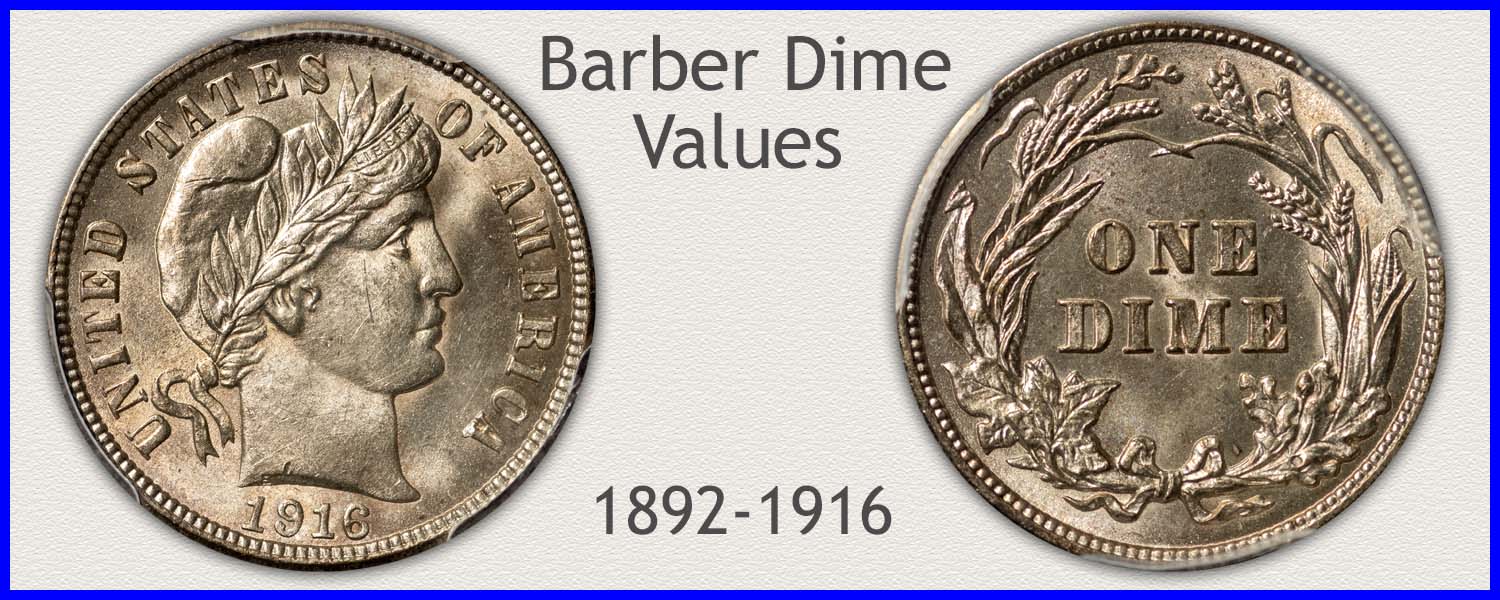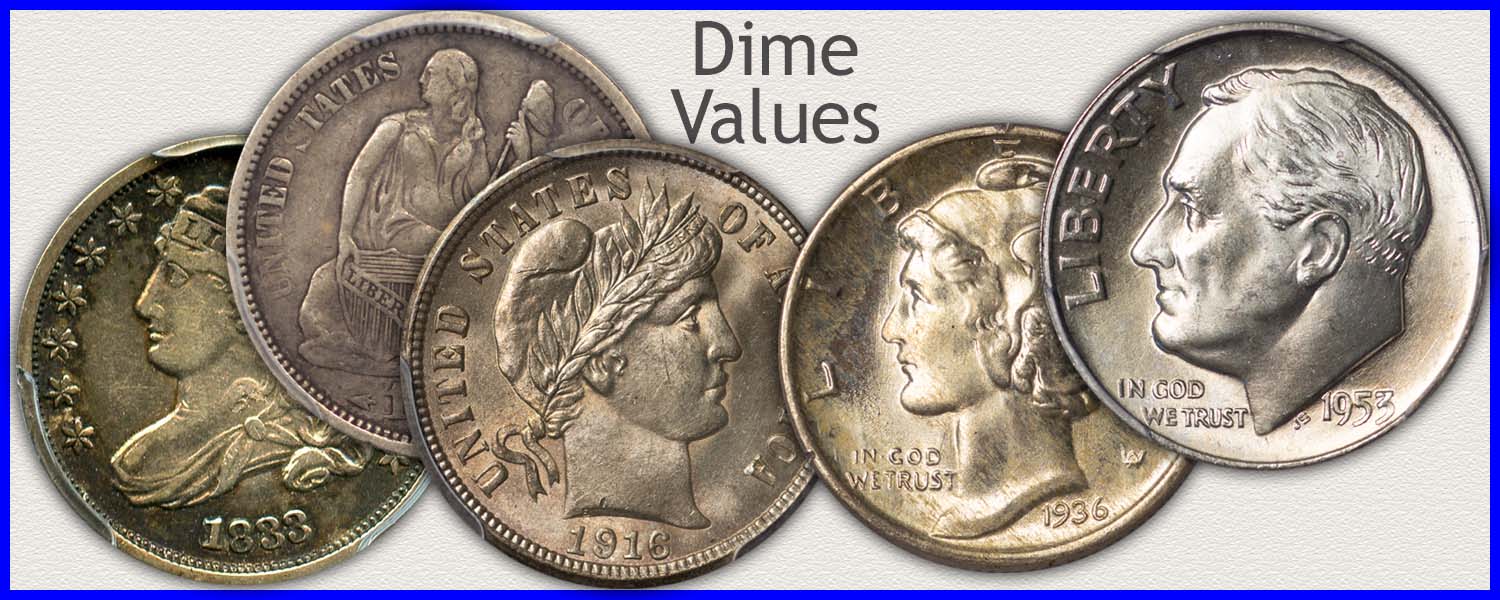Coin Values Moving with Precious Metals: Up-Dated 12/29/2025: Gold $4449 | Silver $75.46
1893 Dime Value
Above average quality vintage dimes are in strong demand by collectors. High 1893 dime value for these coins is reflected in the chart.
A series of images are used in the grading section below to compare the different stages of condition. With your coin in hand and recognizing the important areas of the coin to inspect, a close judgment of condition is made. Add the exact date and mint identity and a narrow range on the chart is found.
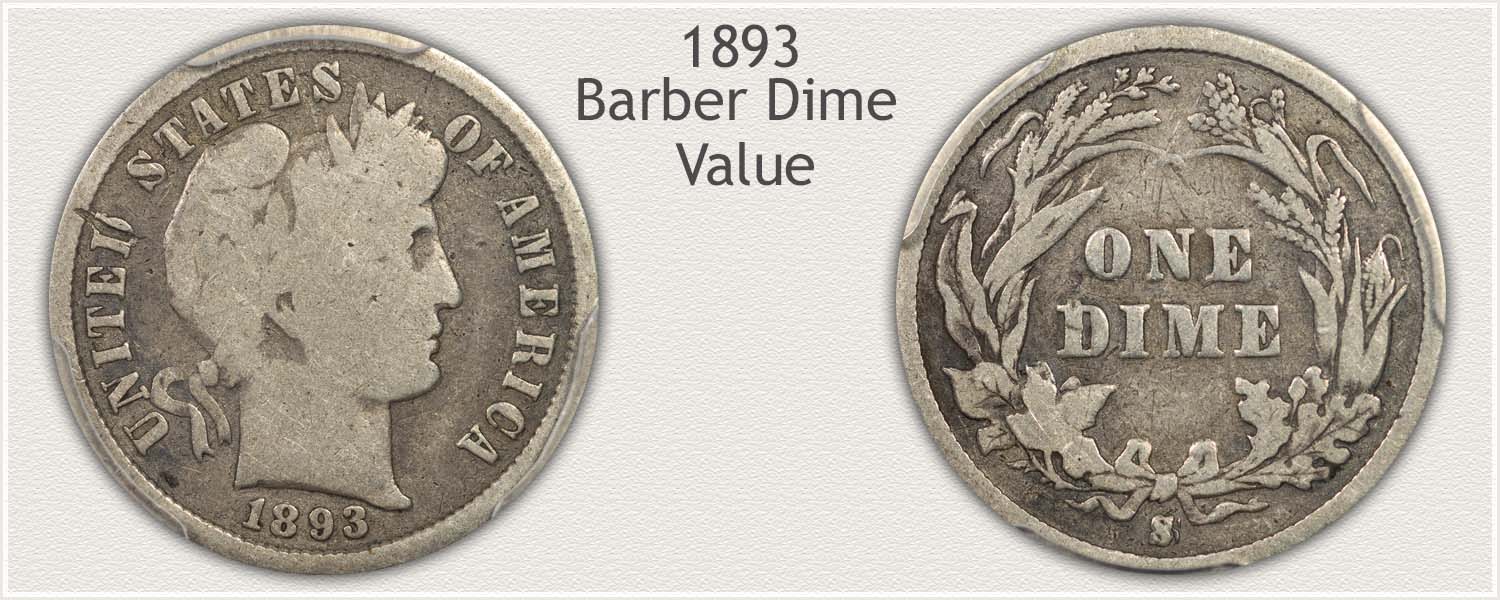
Steps Leading to Value:
- Step 1: Date and Mintmark Variety - Collectible date and mintmark combinations of 1893 dimes are in high demand. These are listed and valued separately on the chart.
- Step 2: Grading Condition - A coin's condition with a significant amount of detail visible is sought by collectors as a premium collectible.
- Step 3: Special Qualities - There are many instances in which values rise as a result of subtle points. To complete the value process, other points are examined.
| 1893 Dime Value | ||||
|---|---|---|---|---|
| Condition of Coin | ||||
| Date | Good | Fine | Extremely Fine | Mint State |
| Barber Dime Values Updated | 12/29/2025 | |||
| 1893 | $22.70 | $27 | $53 | $140 |
| 1893 O | $25 | $99 | $135 | $252 |
| 1893 S | $16 | $39 | $112 | $392 |
Above chart lists wholesale 1893 Barber Dime values. Computed from dealer's price lists and auction records with various mark-up factors figured in.
Step 1: | Date and Mintmark Combination Confirmed
Identify Premium Mint Issue 1893 Dime
There are very different values of 1893 dimes depending on the mint of issue. Of the three mints in production the value chart shows branch mint issues at a premium
Mintmarks identify each of the Branch mints coinage. Small letters within the design are used to recognize a mint's production. All early era Barber dimes are becoming premium coins.
1893-S Barber Dime
"S" Mintmark on Reverse: San Francisco Mint Struck the Coin
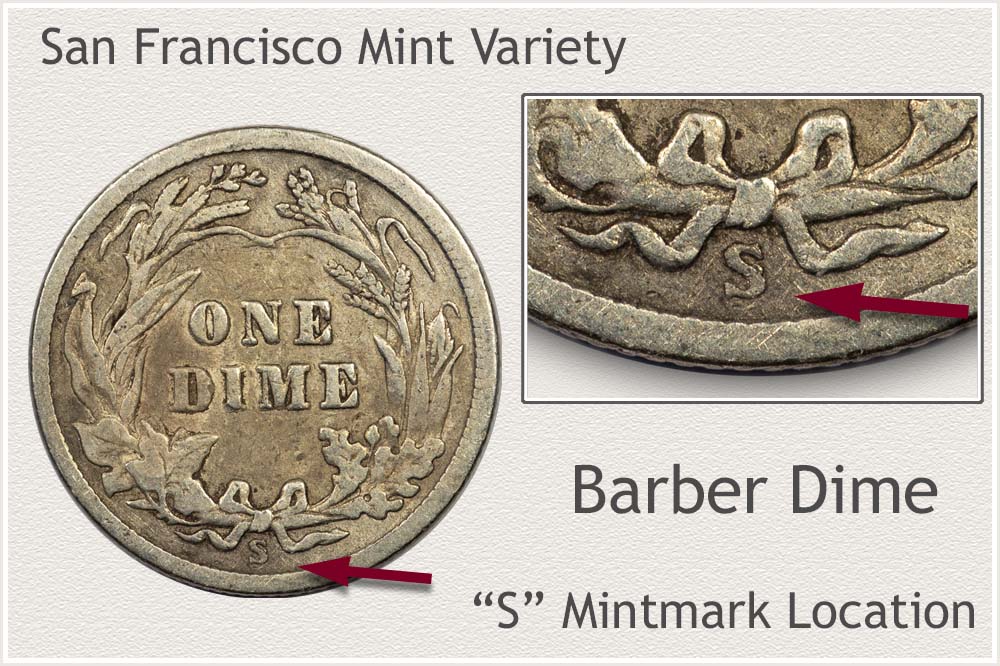
The San Francisco mint increased production of dimes in 1893, recording over 2.4 million struck and released into circulation. These are worth well over their base silver value and not often found in nice condition. Collectors seek a well detailed example to include in sets of Barber dimes.
San Francisco used an "S" mintmark to identify its production of dimes. Inspect the reverse, below the bow, if an "S" is present, it is the San Francisco variety.
1893-O Barber Dime
"O" Mintmark on Reverse: New Orleans Mint Struck the Coin
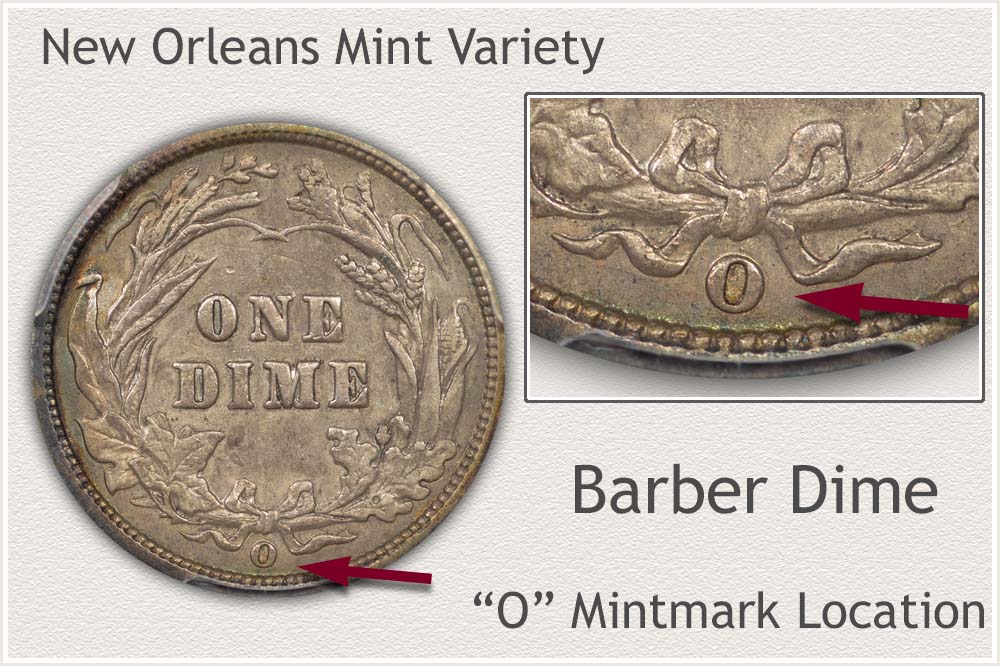
During 1893, the second year of the Barber series, saw a reduction of dimes produced. The New Orleans mint variety is an infrequent coin encountered, partly due to its low 1.7 million mintage total. Collectors place a strong premium on these in all levels of preservation. Today, early era Barber coinage needs a close examination to accurately value.
Mintmarks are used by the branch mints to identify their coins. New Orleans mint issues are identified by an "O" mintmark on the reverse. Look at the bottom center, under the bow, the "O" confirms the New Orleans variety.
1893 Barber Dime
No Mintmark on Reverse: Philadelphia Mint Struck the Coin
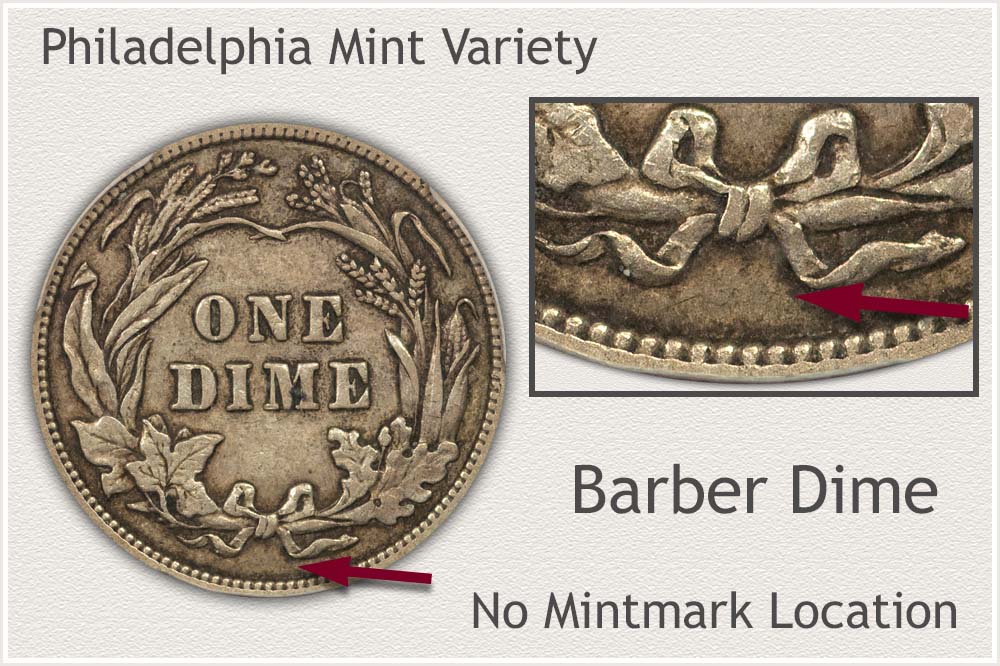
A Philadelphia variety 1893 dime enjoys the status as the fourth lowest mintage of the mint for the series. Just over 3.3 million were produced, a large reduction from a typical yearly number of dimes. Pleasing examples with visible finer details are in demand and a premium collectible.
Philadelphia coinage is recognized by the absence of a mintmark on the reverse. A close examination shows the space between the trailing ribbon ends is empty. At the time, no mintmark was used by the Philadelphia mint.
Step 2: | Judge Condition to Narrow 1893 Dime Value
Collector Quality Grade to Identify
It is important to inspect 1893 dimes closely to judge their condition and identify a high-quality example. Today, most examples of these dimes are in poor condition. Identifying key elements in the design indicates an above-average coin.
Grading involves comparing the surface condition with images of different grades to find a match.
Mint State Grade
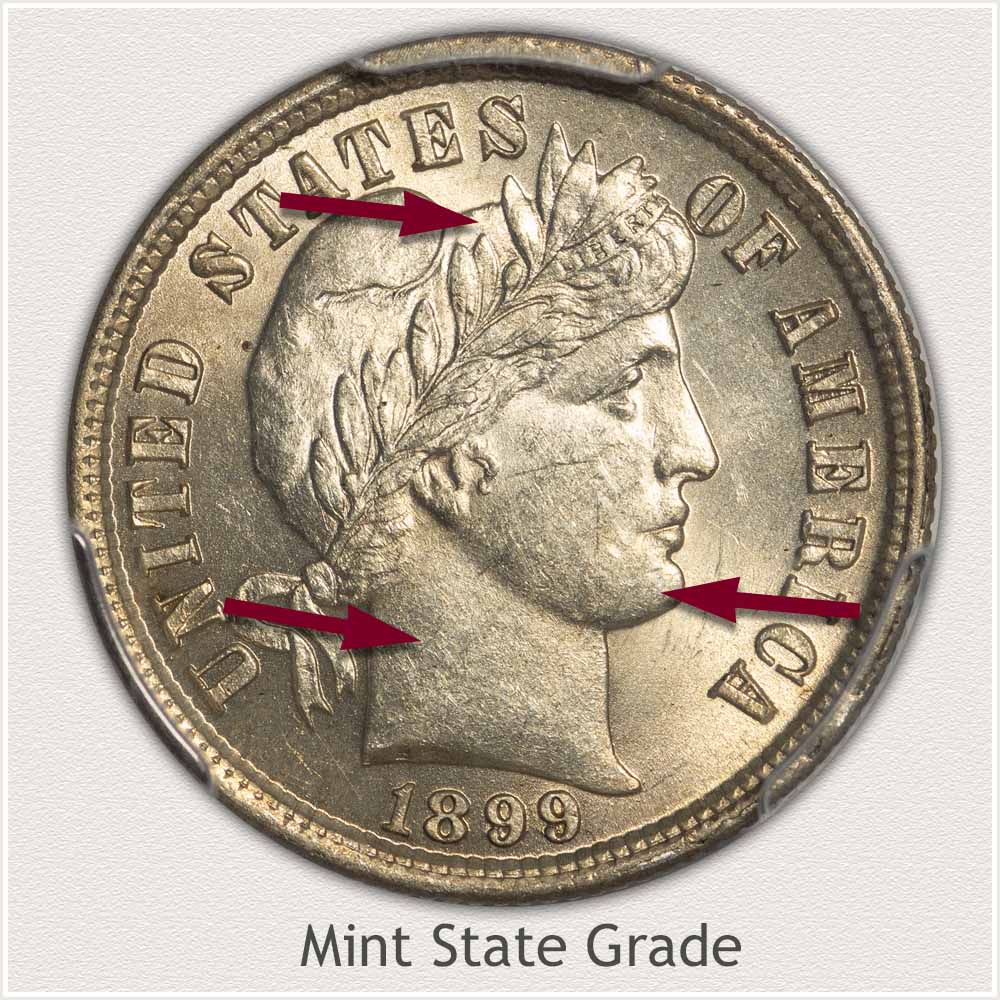
Mint State: When evaluating the condition of these Barber dimes, begin with examining a Mint State example. This grade exhibits the coin with all of its original details as minted. The portrait of Liberty and the coin's fields remain in excellent condition. The Mint State grade is defined by no wear.
In order to detect the absence of wear, inspect the highest points of design and open surfaces, both are prone to metal removal. Liberty's jaw line from ear to chin across the middle of the dime is quick to wear. The original luster imparted during striking is a fine, delicate texture that produces the shine. When a coin is in circulation, its luster quickly wears away and becomes dull.
Second, confirming that the example dime has no wear, shine and original texture remains on the laurel leaves right above the headband near the "L" in Liberty. These two leaves are high relief and become smooth and flatten if worn.
Barber dimes in mint state condition exhibit all of their original details and brilliance. When the coin is rotated under a single light source, a shine moves with the light across the surface.
Extremely Fine Grade
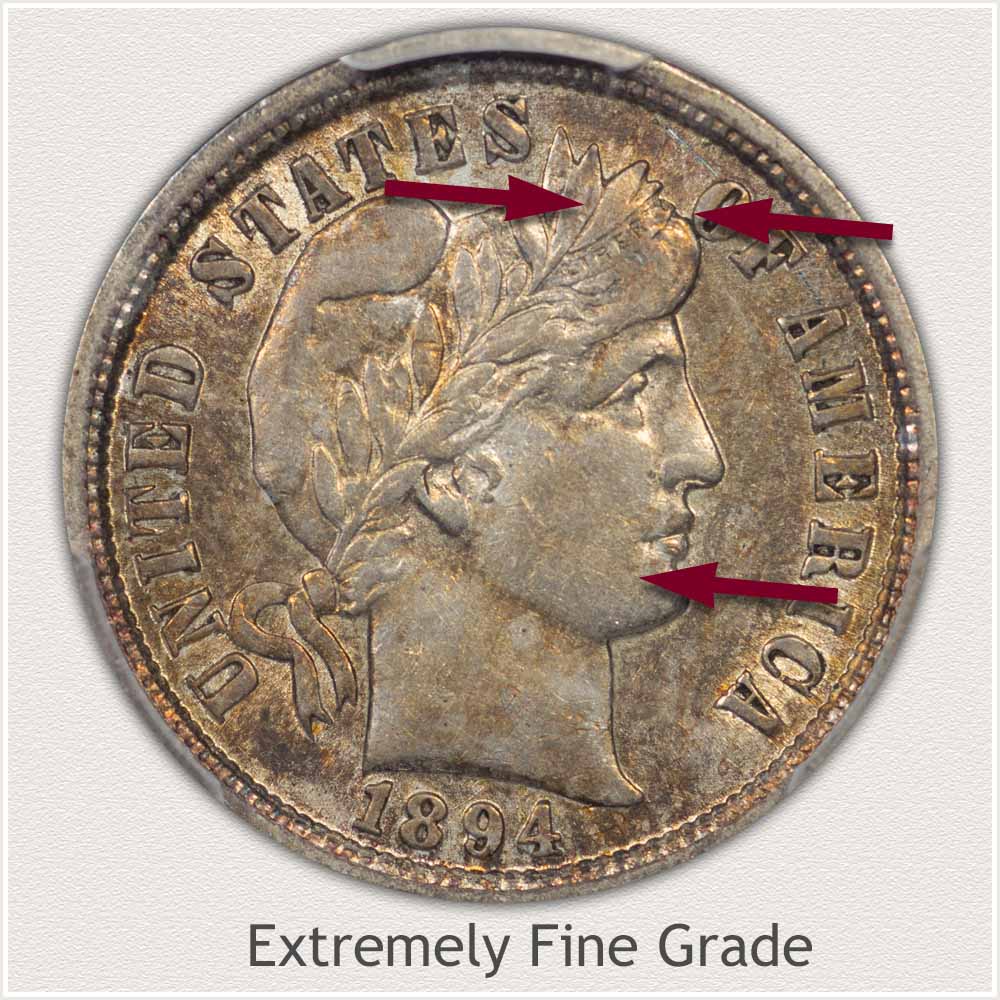
Extremely Fine: Wear is just slightly evident on Barber dimes in Extremely Fine condition. Part of the definition of the grade is wear restricted to high points of the design only. These coins are very sharp in appearance when viewed overall. Close-up inspection confirms all fine details remain identifiable. Small lines in the leaves, condition of the headband, and overall, the amount of light wear is important to confirm a collectible grade dime.
A major element of the Extremely Fine grade is all letters of "Liberty" within the headband are full and well defined. As one of the highest parts of the design, the ribbon of the headband with lettering remains complete, including a top and bottom edge.
Helping indicate only light wear is the remaining fine strands of hair just over the forehead. Wear has flattened the hair slightly; the remaining hair strands point to just light wear, helping indicate a high-quality dime.
Quality of the open areas is next inspected. With just slight wear, the cheek and neck retain their contoured high and low reliefs. Small areas of smoothness are starting to show on the tops of the contours. The overall tone of the silver is a soft grey. Most of the high areas are well rounded. Inspect the cap as well, it is fully detailed with strong contours. The example dime is well within the collectible and valuable range of Extremely Fine grade.
Fine Grade
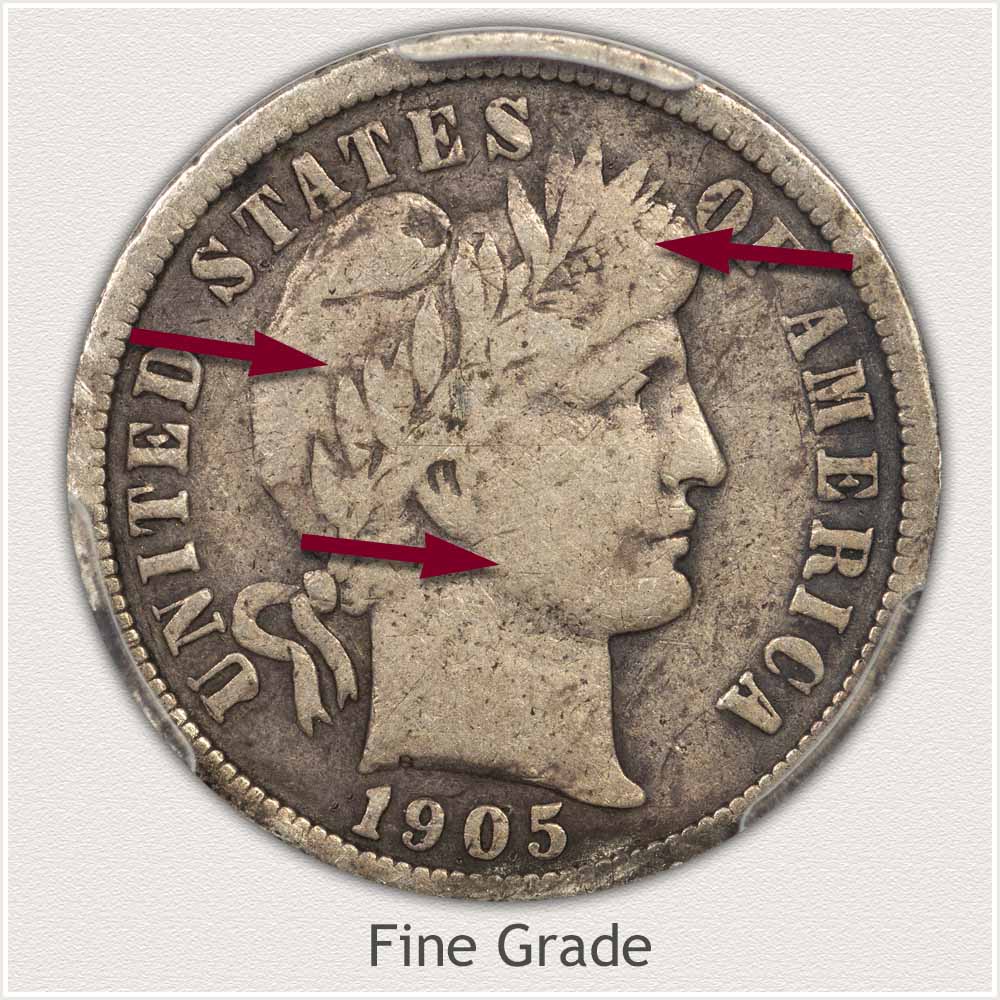
Fine Grade: Many details remain visible on a Fine condition Barber dime. Moderate wear helps define the grade with evident details of leaves, cap, and ribbon in Liberty's hair.
First consideration is the overall look of the coin gives the impression of areas of crisp detail. All leaves of the Laurel branch pointing upward are fully defined. Edges of the leaves are separate and only merge where they overlap. Lower row of leaves is less defined and forms a flattened area extending from Liberty's ear to her forehead.
Looking at the headband ribbon, all letters of "Liberty" are visible. Here the ribbon has lost its upper and lower edges, and a slight amount of fading to the letters "ER" is often seen. It is important the lettering on the headband is strong and readable.
Liberty's cheek is a flattened area with a small amount of contour under her eye. Additionally, her cap is in better condition, with only a small line of wear along the upper edge leaving rounded contours close to the Laurel branch.
Major design features are still bold, adding to the appeal of the grade, making it a nice collectible of the Barber dime series.
Good Grade
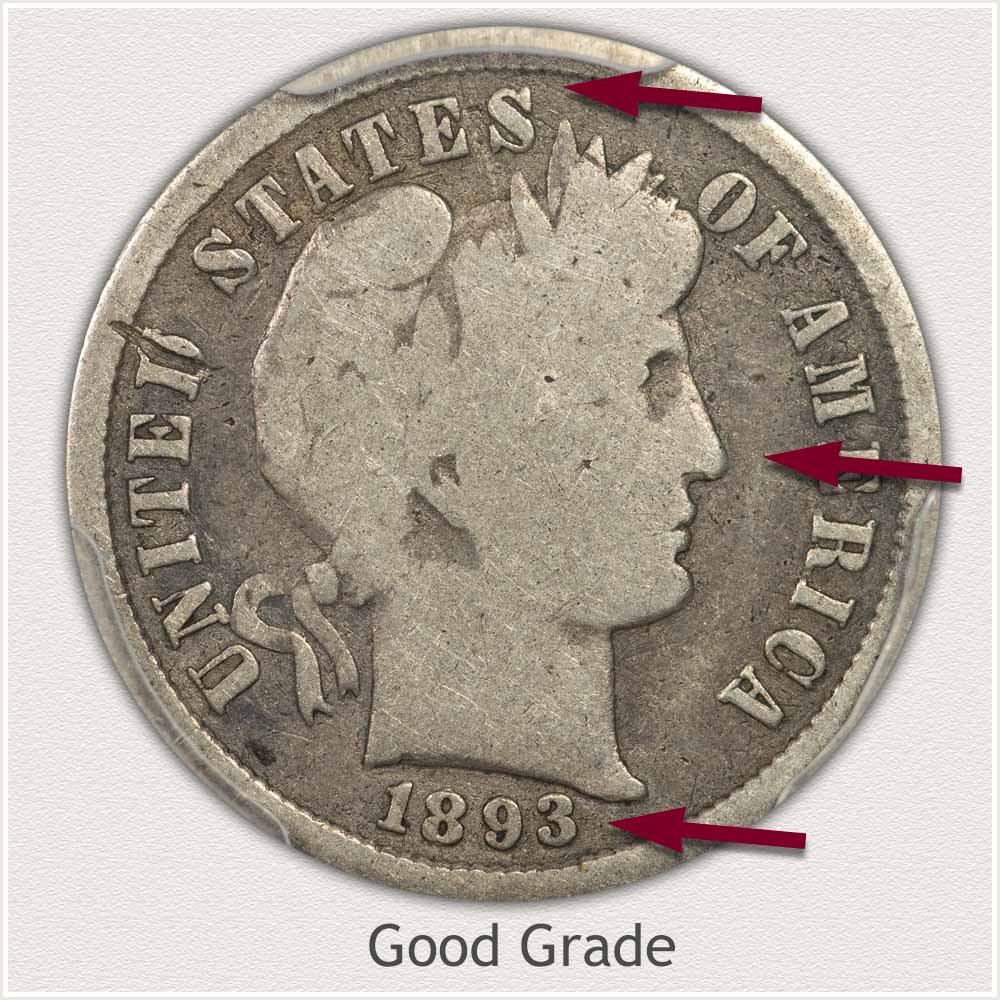
Good Grade: Noticeable, heavy wear is the definition of Barber dimes in Good condition. A coin visibly worn to the point all fine detail is missing, along with the majority of major detail smooth. One quality adding to collectability, these coins display the appearance of worn but not "worn out" at first impression.
Placing the example in Good grade is the flat, outlined portrait of Liberty. Few details within the face and hair remain. A plus quality is the portrait is fully raised from the field.
An important factor holding the coin within the grade is complete lettering along the rim and a very bold date. The full rim adds to the charm of the overall appearance. A nice example for the grade, displaying even wear with pleasant remaining details.
How to Video: Grading Barber Dimes
A few factors are important to confirming a grade at each stage of condition. By highlighting additional details with photographs, it is easier to discern the true preservation of these old dimes.
Video, Images and Descriptions | Grading Barber Dimes
Step 3: | Special Qualities | Confidently Recognize Collectible Barber Dimes
Above Average Quality 1893 Dimes
You have determined your coin is an 1893 Barber dime and the Philadelphia issue. Just missing the premium New Orleans or San Francisco mint varieties. A further evaluation is now the focus to finding qualities of the coin appealing to collectors and possible higher value.
Two main markets are the base to value on the above chart. At the low end are "Bullion" silver values. These support the silver content found in all Barber dimes. At $22.70 an 1893 does have a small premium above intrinsic silver worth.
Second market is the Collector market, interest is in quality and scarcity attached to higher quality examples.
Have a close look at your coin, easily spotted are problems lowering overall condition.
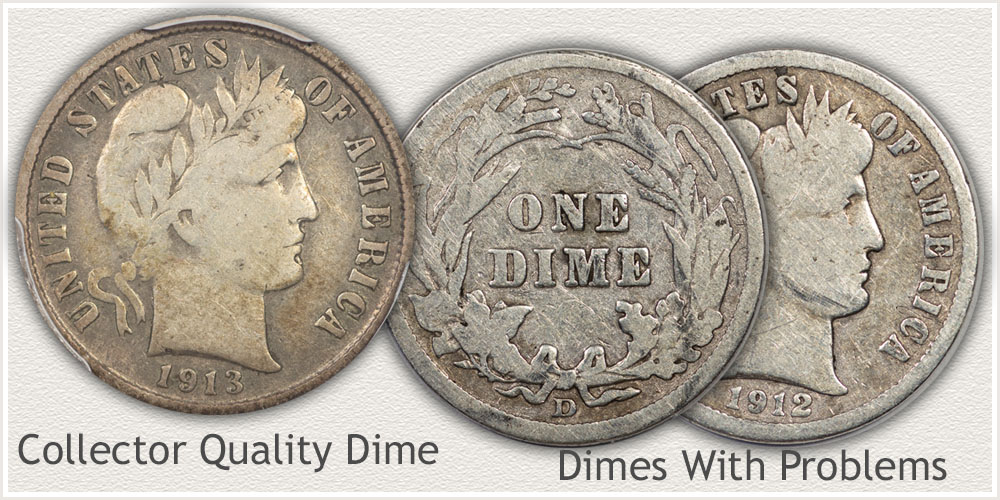
Imaged is a coin on the left with nice qualities sought by collectors. To the right are examples with visible marks, dark discoloration, and unnatural brightness of cleaned surfaces. Your coin avoiding these problems is of higher quality.
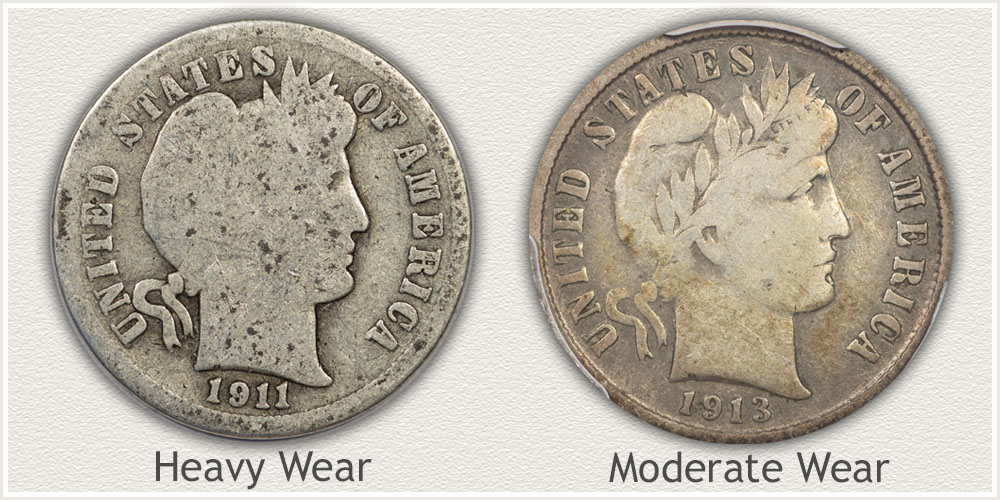
Second confirming factor is to note the visual difference of the examples above. Heavy wear on the left and a pleasing amount of detail showing on the right-hand example. The fact all letters of "Liberty" are visible within the headband of Liberty on the right-hand coin is the deciding point to a collectible quality, premium value dime.
Take a second inspection of your dime. Lack of problems quickly adds quality, add in all letters to "Liberty" in the headband and it is confidently a special quality 1893 Barber dime.
References
U.S. Mint. 1894 U.S. Mint Annual Report https://nnp.wustl.edu/library/publisherdetail/51
Coin Values | CoinStudy Articles
Date by Date
In Depth Barber Dime Values
1892 to 1916
Barber Dime Value | Identify Their Potential Worth
Barber dimes have now become an older series with many date and mint combinations worth well above base silver value. Each is $9.59 because of their 90% silver alloy. Many have low mintage numbers, are scarce and collected in all conditions with strong premiums.
Dime Values | Identify the Different Series
As part of the value process, use the images to identify the dime series. Each is linked to in depth coverage of dates and mints to recognize. The different series are covered with specific grading images to judge condition, one of the important steps to an accurate value.
Old Coin Values | Step by Step
Specific steps are taken by collectors to place values on old coins. Use the method to identify the series, exact date and mint combination, and importantly condition of the coin.
Print the Coin Values Worksheet
Record your collection of old coins in one place. The value sheet organizes the listing of coins, keeping a summary of values. Complete Barber dimes and continue with the rest of your holdings.
Rare Dimes | Early Silver Issues
Spotting a rare dime is often just recognizing the early silver alloy types. A strong base to value, silver as part of coinage was discontinued in 1964. These older dimes are becoming scarce and worth well above ten cents. Early dimes prior to 1900 are all scarce and collectible. Rare dimes of U.S. coinage are featured.
Coin Grading Services | Professional Review of Condition
Coins with values above $100 begin to enter the scarce range. These coins are typically date and mints of low mintage examples. Further, many coins enter the scarce range in higher, better preserved condition. Small and subtle points to grading condition often spots a high value coin. Grading services provide market acceptance of defined grades.
★Coin Values Discovery finds 1893 Dime Value and...
A review of the value process with image links to series and current coin value. Determining how much a collection of coins is worth follows a few steps helped by images and detailed descriptions.
